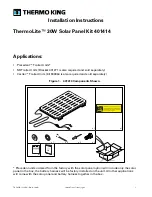
Doc Number 801-00015, Version 1.1, Copyright © 2010 Zep Solar, Inc.
PAGE:
3 of 28
ZEP SYSTEM II INSTALLATION MANUAL
1.0 > Introduction
This manual details installation procedures for the Zep System II PV Module Installation System
(Zep System II) and provides important safety information that the installer should read carefully
in its entirety prior to installation. Failure to follow these instructions may result in death, bodily
injury or property damage. Correct installation of Zep System II components will ensure reliable
structural connections and proper ground bond means throughout the array and from the array to
the equipment grounding conductor(s).
The components detailed in this manual include the Interlock, the Leveling Foot, the Ground Zep,
the Zep Wire Clip, the Zep Comp Mount and the Zep Compatible Solar Module (Module). The word
“Module” as used in this manual will refer specifically to a Zep Compatible PV Module – a PV Module
containing the patented Zep Groove frame design licensed by Zep Solar to the PV Module manufac-
turer. All components covered in this manual are protected by US patent #7,592,537 and/or multiple
pending US & International patents.
The Interlock conforms to UL Standard 1703 and is Listed by Intertek (ETL) with Control Number
4000321. The Ground Zep conforms to UL Standard 467 and is Listed by Intertek (ETL) with Control
Number 4000321.
2.0 > Safety Precautions
WARNING:
All instructions in this Installation Manual and all instructions in the installation
manual provided by the manufacturer of the Module should be read and understood before at-
tempting to install Zep System II. The installer assumes all risk of personal injury or property
damage that might occur during the installation and handling of the components.
2.1 > General Safety
1. All installations must be performed in compliance with all applicable regional and local codes,
such as the latest National Electric Code (USA), Canadian Electric Code (Canada) or other national
or international electrical standards.
2. Follow all safety precautions detailed in this Installation Manual as well as the Module instal-
lation manual.
3. Comply with all applicable OSHA or equivalent safety standards including but not limited to the
proper use of regulation fall protection equipment.
4. Do not perform any installations in wet or windy conditions.




































